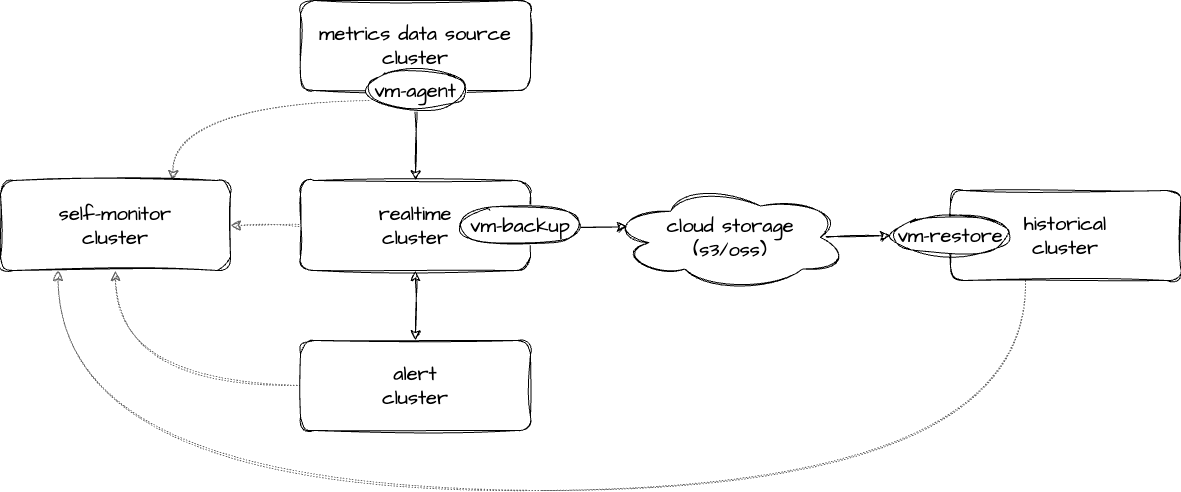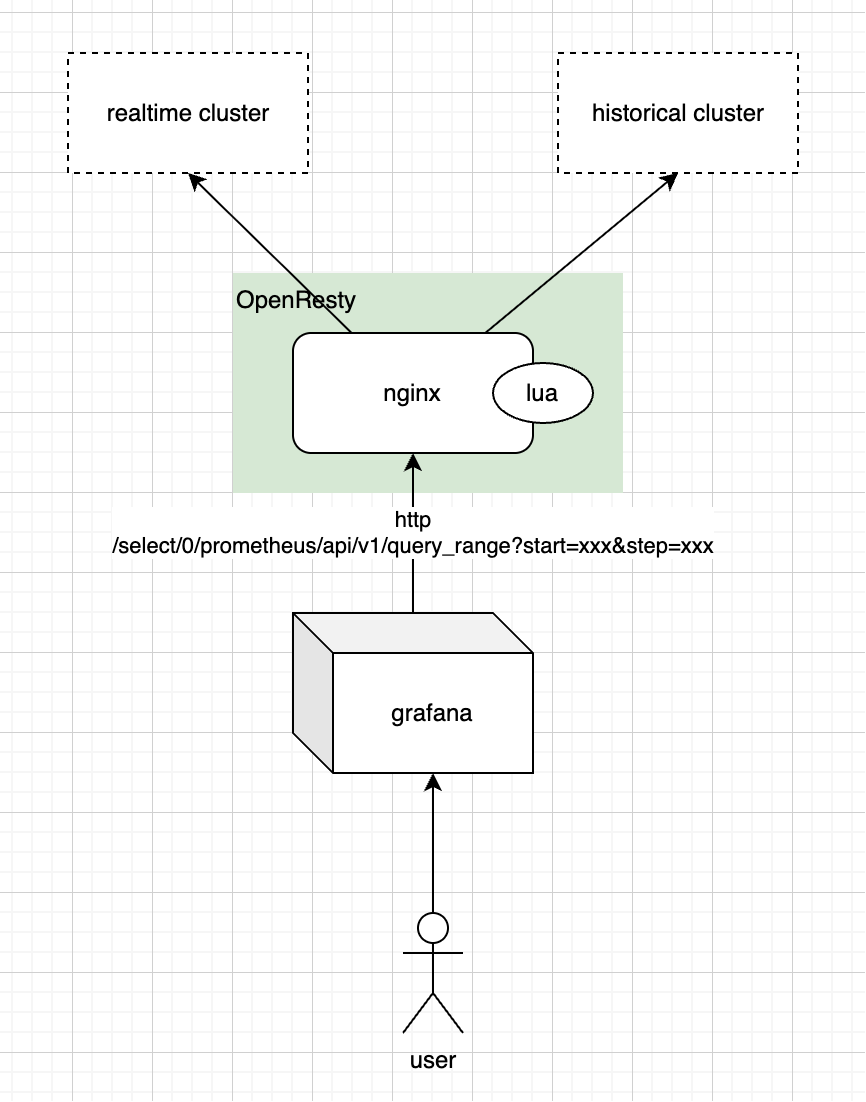作者:張富春(ahfuzhang),轉載時請註明作者和引用鏈接,謝謝!
- cnblogs博客
- zhihu
- Github
- 公眾號:一本正經的瞎扯
![]()
我曾設計了這樣的 VictoriaMetrics 中的實時羣集和歷史羣集:

see: deploy_VictoriaMetrics_cluster
期待的效果是:
- 實時羣集存儲最近 7 天的數據,保障足夠快足夠可靠,提供告警查詢和當前的系統監控。
- 為了保障實時羣集的穩定性,通過犧牲存儲時間來減少存儲的數據
- 歷史羣集提供長週期的(例如半年),且降採樣的數據的存儲
- 以低成本的方式提供長週期的數據查詢
部署完成後,我部署了一個新的 vmselect 節點,來連接到所有的實時羣集和歷史羣集的vmselect節點上。
可是當我執行如下的查詢時,發現數據是正確數據的兩倍:
sum by (path) (increase(http_request_total{job="myApp"}[1m]))
很明顯, sum() 時,把實時羣集和歷史羣集中同樣的 time series 上的值加了兩次。
研究過 dedup 的源碼,並未發現明顯問題。
無奈,只能通過別的辦法繞過去。
於是想到:如果能夠自動發現用户查詢的時間範圍,當用户查詢七天以內時轉發到實時羣集,而查詢超過七天就轉到歷史羣集,那麼就不用把歷史羣集和實時羣集混合在一起了。
下面是這個思路的詳細解決辦法:

部署 openresty 的 deployment 的代碼如下:
# openresty.yaml
# nginx 的配置文件放在 configMap 中
apiVersion: v1
kind: ConfigMap
metadata:
name: openresty-config
data:
# nginx 的 配置文件
nginx.conf: |
worker_processes 1;
events {
worker_connections 1024;
}
http {
access_log /dev/stdout;
error_log /dev/stderr warn;
lua_package_path "/usr/local/openresty/nginx/lua/?.lua;;";
upstream realtime {
server vmselect-realtime:8481; # 實時羣集的 vmselect
}
upstream historical {
server vmselect-historical:8481; # 歷史羣集的 vmselect
}
server {
listen 8401;
location /select/0/prometheus/api/v1/query_range { # 核心是修改 query_range 這條 api
content_by_lua_file /usr/local/openresty/nginx/lua/router.lua;
}
# 其它所有路徑默認走 realtime
location / {
proxy_pass http://realtime;
}
location @toRealtime {
proxy_pass http://realtime;
}
location @toHistorical {
proxy_pass http://historical;
}
}
}
# lua 腳本的代碼
router.lua: |
-- 時間值要支持三種格式:數值,字符串,grafana中的簡寫
local function parse_start(val)
if not val then return nil end
local num = tonumber(val)
if num then
if num > 1e12 then
return math.floor(num / 1000)
else
return num
end
end
local year, mon, day, hour, min, sec =
val:match("^(%d+)%-(%d+)%-(%d+)T(%d+):(%d+):(%d+)")
if year then
return os.time({
year = tonumber(year),
month = tonumber(mon),
day = tonumber(day),
hour = tonumber(hour),
min = tonumber(min),
sec = tonumber(sec)
})
end
local num, unit = val:match("^([%-]?%d+)([smhdw])$")
if num and unit then
num = tonumber(num)
local seconds = 0
if unit == "s" then seconds = num
elseif unit == "m" then seconds = num * 60
elseif unit == "h" then seconds = num * 3600
elseif unit == "d" then seconds = num * 86400
elseif unit == "w" then seconds = num * 7 * 86400
end
return ngx.time() + seconds
end
return nil
end
local args = ngx.req.get_uri_args()
local is_post = (ngx.req.get_method() == "POST")
local post_args = {}
if is_post then
ngx.req.read_body()
post_args = ngx.req.get_post_args()
for k,v in pairs(post_args) do
args[k] = v
end
end
local start = parse_start(args["start"])
local now = ngx.time()
local days = 7 -- 這裏設定一個七天的範圍:七天以內在實時羣集查詢,超過七天在歷史羣集查詢
local n_days_ago = now - days*24*3600
local step = "300s" -- 當查詢歷史羣集時,使用歷史羣集的降採樣後的間隔,即 5 分鐘
if start ~= nil then
if start > n_days_ago then
return ngx.exec("@toRealtime")
else
if is_post then
post_args["step"] = step
local body_tbl = {}
for k,v in pairs(post_args) do
table.insert(body_tbl, ngx.escape_uri(k) .. "=" .. ngx.escape_uri(v))
end
local new_body = table.concat(body_tbl, "&")
ngx.req.set_body_data(new_body)
else
args["step"] = step
ngx.req.set_uri_args(args)
end
return ngx.exec("@toHistorical")
end
else
return ngx.exec("@toRealtime")
end
---
# 這裏是部署 openresty 的 deployment
apiVersion: apps/v1
kind: Deployment
metadata:
name: openresty
spec:
replicas: 1
selector:
matchLabels:
app: openresty
template:
metadata:
labels:
app: openresty
spec:
containers:
- name: openresty
image: openresty/openresty:1.27.1.2-alpine
ports:
- containerPort: 8401
volumeMounts:
- name: config
mountPath: /usr/local/openresty/nginx/conf/nginx.conf
subPath: nginx.conf
- name: config
mountPath: /usr/local/openresty/nginx/lua/router.lua
subPath: router.lua
command: ["/usr/local/openresty/bin/openresty"]
args: ["-g", "daemon off;", "-c", "/usr/local/openresty/nginx/conf/nginx.conf"]
volumes:
- name: config
configMap:
name: openresty-config
---
apiVersion: v1
kind: Service
metadata:
name: openresty
spec:
selector:
app: openresty
ports:
- protocol: TCP
port: 8401
targetPort: 8401
type: ClusterIP
通過命令行部署:
KUBECONFIG=~/my-test-k8s.yaml kubectl apply -f ./openresty.yaml -n my-namespace
通過 grafana 創建新的數據源,或者可以使用命令查詢:
curl -G "http://127.0.0.1:8401/select/0/prometheus/api/v1/query_range?start=-7d" -v
可以通過 header X-Server-Hostname 觀察數據由哪個服務返回。
Have Fun. 😃













